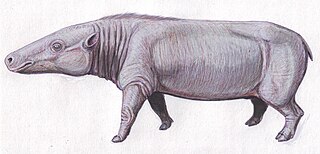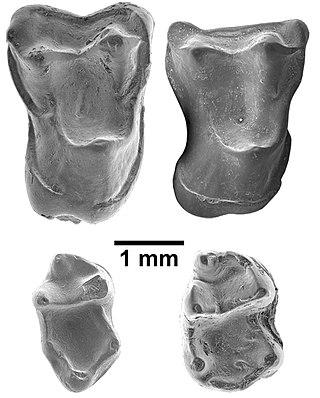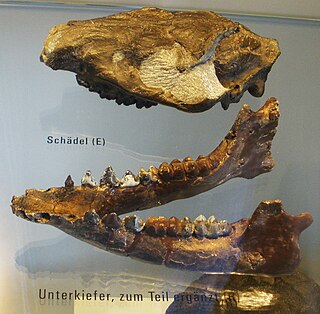
The hippopotamus (; pl.: hippopotamuses; also shortened to hippo, further qualified as the common hippopotamus, Nile hippopotamus, or river hippopotamus, is a large semiaquatic mammal native to sub-Saharan Africa. It is one of only two extant species in the family Hippopotamidae, the other being the pygmy hippopotamus. Its name comes from the ancient Greek for "river horse".

Artiodactyls are placental mammals belonging to the order Artiodactyla. Typically, they are ungulates which bear weight equally on two of their five toes. The other three toes are either present, absent, vestigial, or pointing posteriorly. By contrast, most perissodactyls bear weight on an odd number of the five toes. Another difference between the two orders is that many artiodactyls digest plant cellulose in one or more stomach chambers rather than in their intestine. Molecular biology, along with new fossil discoveries, has found that cetaceans fall within this taxonomic branch, being most closely related to hippopotamuses. Some modern taxonomists thus apply the name Cetartiodactyla to this group, while others opt to include cetaceans within the existing name of Artiodactyla. Some researchers use "even-toed ungulates" to exclude cetaceans and only include terrestrial artiodactyls, making the term paraphyletic in nature.

Hippopotamidae is a family of stout, naked-skinned, and semiaquatic artiodactyl mammals, possessing three-chambered stomachs and walking on four toes on each foot. While they resemble pigs physiologically, their closest living relatives are the cetaceans. They are sometimes referred to as hippopotamids.

Anthracotherium is an extinct genus of artiodactyls characterized by having 44 teeth, with five semi-crescentic cusps on the crowns of the upper molars. The genus ranged from the middle Eocene period until the early Miocene, having a distribution throughout Eurasia. Material subjectively assigned to Anthracotherium from Pakistan suggests the last species died out soon after the start of the Miocene.

Elomeryx is an extinct genus of artiodactyl ungulate, and is among the earliest known anthracotheres. The genus was extremely widespread, first being found in Asia in the middle Eocene, in Europe during the latest Eocene, and having spread to North America by the early Oligocene. The closest living relatives of the Elomeryx are bovids, suids, and cetaceans.

Anthracotheriidae is a paraphyletic family of extinct, hippopotamus-like artiodactyl ungulates related to hippopotamuses and whales. The oldest genus, Elomeryx, first appeared during the middle Eocene in Asia. They thrived in Africa and Eurasia, with a few species ultimately entering North America during the Oligocene. They died out in Europe and Africa during the Miocene, possibly due to a combination of climatic changes and competition with other artiodactyls, including pigs and true hippopotamuses. The youngest genus, Merycopotamus, died out in Asia during the late Pliocene, possibly for the same reasons. The family is named after the first genus discovered, Anthracotherium, which means "coal beast", as the first fossils of it were found in Paleogene-aged coal beds in France. Fossil remains of the anthracothere genus were discovered by the Harvard University and Geological Survey of Pakistan joint research project (Y-GSP) in the well-dated middle and late Miocene deposits of the Pothohar Plateau in northern Pakistan.

Merycopotamus is an extinct genus of Asian anthracothere that appeared during the Middle Miocene, and died out in the Late Pliocene. At the height of the genus' influence, species ranged throughout South Asia. With the extinction of the last species, M. dissimilis, the lineage of anthracotheres came to an end. Merycopotamus was closely related to the anthracothere genus Libycosaurus, which, unlike the former, never left Africa. In fact, some African fossils originally placed in Merycopotamus, but are now referred to Libycosaurus.

Sinonyx is a genus of extinct, superficially wolf-like mesonychid mammals from the late Paleocene of China. It is within the family Mesonychidae, and cladistic analysis of a skull of Sinonyxjiashanensis identifies its closest relative as Ankalagon. S.jiashanensis was discovered in Anhui province, China, in the Tuijinshan formation.
Anthracothema was a genus of extinct artiodactyl ungulate mammals that lived in Myanmar during the late Eocene.

Anthracokeryx is a genus of extinct artiodactyl ungulate mammal belonging to Anthracotheriidae that lived in Asia during the middle to late Eocene.
Anthracohyus was a genus of extinct artiodactyl ungulate mammal belonging to Anthracotheriidae that lived in Asia during the middle to late Eocene.

Paraentelodon is an extinct entelodont from the Late Oligocene and Oligocene-Miocene boundary of Asia. The fossils of the type species P. intermedium were found in Georgia, Kazakhstan and China. An indeterminate species represents in Bugti Hills which is the late Oligocene of Pakistan.
Dermotherium is a genus of fossil mammals closely related to the living colugos, a small group of gliding mammals from Southeast Asia. Two species are recognized: D. major from the Late Eocene of Thailand, based on a single fragment of the lower jaw, and D. chimaera from the Late Oligocene of Thailand, known from three fragments of the lower jaw and two isolated upper molars. In addition, a single isolated upper molar from the Early Oligocene of Pakistan has been tentatively assigned to D. chimaera. All sites where fossils of Dermotherium have been found were probably forested environments and the fossil species were probably forest dwellers like living colugos, but whether they had the gliding adaptations of the living species is unknown.

Afrasia djijidae is a fossil primate that lived in Myanmar approximately 37 million years ago, during the late middle Eocene. The only species in the genus Afrasia, it was a small primate, estimated to weigh around 100 grams (3.5 oz). Despite the significant geographic distance between them, Afrasia is thought to be closely related to Afrotarsius, an enigmatic fossil found in Libya and Egypt that dates to 38–39 million years ago. If this relationship is correct, it suggests that early simians dispersed from Asia to Africa during the middle Eocene and would add further support to the hypothesis that the first simians evolved in Asia, not Africa. Neither Afrasia nor Afrotarsius, which together form the family Afrotarsiidae, is considered ancestral to living simians, but they are part of a side branch or stem group known as eosimiiforms. Because they did not give rise to the stem simians that are known from the same deposits in Africa, early Asian simians are thought to have dispersed from Asia to Africa more than once prior to the late middle Eocene. Such dispersals from Asia to Africa also were seen around the same time in other mammalian groups, including hystricognathous rodents and anthracotheres.

Protaceratherium is an extinct genus of rhinocerotid from the Oligocene and Miocene of Eurasia.

Microbunodon was a genus of extinct artiodactyl mammals in the family Anthracotheriidae. It lived between the upper Eocene and the lower Pliocene. Its fossil remains have been found in Europe and Asia.

The microbunodontines were an extinct subfamily of anthracotheres that were predominately a Paleogene group of Eurasian artiodactyls. The group died out at the end of the Late Miocene. It comprised the genera Anthracokeryx, Geniokeryx, Microbunodon, and possibly Etruscotherium. They are different from the other anthracothere lineages by their smaller size, slenderer limbs and male specimens having laterally compressed, longer canines. They were originally classified as members of the other subfamily of anthracotheres, Anthracotheriinae but recent phylogenetic studies have found them to be their own clade which is sister to Bothriodontinae.

The anthracotheriines are an extinct subfamily of anthracotheres that comprised Paleogene to early Neogene North American and Eurasian artiodactyls. The group contained the genera Anthracotherium, Heptacodon, and Paenanthracotherium, as well as possibly Myaingtherium and Siamotherium. They were small to large sized anthracotheres, and when compared to the other two subfamilies, Microbunodontinae and Bothriodontinae, anthracotheriines are found to occupy a primitive, basal position in the family.

Ancodonta is an infraorder of artiodactyl ungulates including modern hippopotamus and all mammals closer to hippos than to cetaceans (whales). Ancodonts first appeared in the Middle Eocene, with some of the earliest representatives found in fossil deposits in Southeast Asia. Throughout their evolutionary history they have occupied different browsing and grazing niches in North America, Eurasia and Africa. The last continent is notable as they were among the first laurasiatherian mammals to have migrated to Africa from Europe, where they competed with the native afrothere herbivores for the same niches. Of the nearly 50 genera that have existed, only two of them are extant – Choeropsis and Hippopotamus. The interrelationships within the ancodonts has been contended. The traditional notion is that there at minimum two families Anthracotheriidae and Hippopotamidae and were merely sister taxa. However many detailed research of the dentition among ancodonts, as well as how some anthracotheres were similar to hippos in appearance, lead the current consensus where Anthracotheriidae is paraphyletic to Hippopotamidae. Among the anthracotheres, members of Bothriodontinae are among the closest to the ancestry of hippos, with the Oligocene aged Epirigenys from Lokon, Turkana, Kenya being the sister taxon to hippos. In response of this many similar clade names have been used for this clade.
Heptacodon is an extinct genus of anthracothere endemic to North America during the Paleogene. They were medium to large-sized anthracotheres with distinct facial features, such as short heavy rostrums and robust but simple molars. Heptacodon is a member of the anthracothere subfamily Anthracotheriinae, whose distribution as a whole included North America and Eurasia. However Heptacodon has only been found in North America, with the species H. yeguaensis from Texas representing the oldest known anthracotheres to be found in North America dating to the middle Eocene. Fossils of this genus have been found in the states of North Dakota, Oregon, South Dakota, Texas, and Utah.















